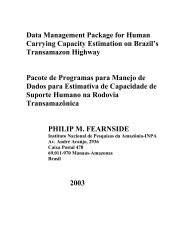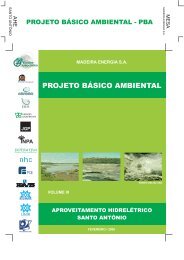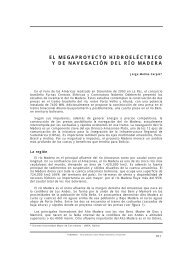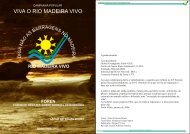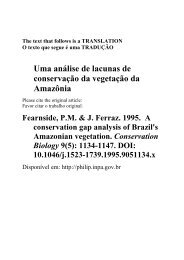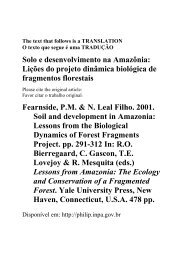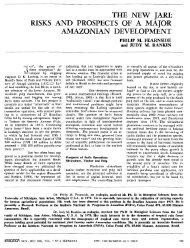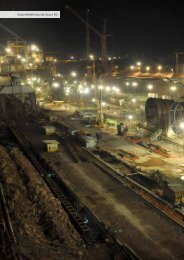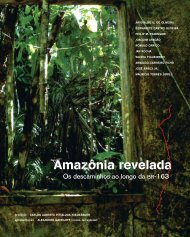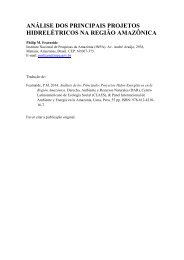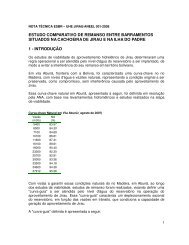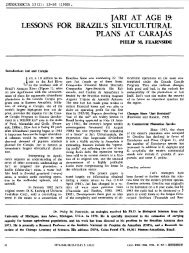THE FUTURE OF THE AMAZON - Philip M. Fearnside - Inpa
THE FUTURE OF THE AMAZON - Philip M. Fearnside - Inpa
THE FUTURE OF THE AMAZON - Philip M. Fearnside - Inpa
Create successful ePaper yourself
Turn your PDF publications into a flip-book with our unique Google optimized e-Paper software.
13(Nepstad et al. 1998, Cochrane and Schulze 1998, 1999).Second, the non-optimistic model assumes that protected areas within 50 km ofhighways and roads will be lightly to moderately degraded. In fact, many protectedareas in the Amazon are little more than “paper parks” with inadequate protection.Ferreira et al. (1999) evaluated 86 federal parks and protected areas in Brazil and foundthat 43% were at high to extreme risk because of illegal deforestation, colonization,hunting, isolation of the reserve from other forest areas, and additional forms ofencroachment. More than half of all reserves (54.6%) were judged to have nearly nonexistentmanagement. For some reserves, even our non-optimistic model may beoverly optimistic.The fates of Amerindian lands will have an important impact on forestconservation, because they currently encompass some 18% of the Brazilian LegalAmazon (and about 21% of the forested area of the region). In many areas, the qualityof environmental protection as well as traditional lifestyles have declined markedly asindigenous groups come into more frequent contact with outsiders (Margolis 2000). Inthis sense, reducing construction of new roads and highways near indigenous landsmay be one of the most effective measures to ensure that traditional managementsystems are not corrupted.Other investigators have also attempted to predict spatial patterns of Amazoniandeforestation. Recent studies by a Brazilian non-governmental organization haveattempted to predict the extent of deforestation that will be caused by new highwayconstruction under the Avança Brasil program (Nepstad et al. 2000, 2001, Carvalho etal. 2001), but did not consider the effects of other infrastructure projects (hydroelectricreservoirs, power lines, gas lines, railroads, river-channelization projects, and theirassociated road networks) on forests (cf. <strong>Fearnside</strong> 2002). In addition, an ongoingstudy by C. Souza Jr. (pers. comm.) is using data on existing road networks, logging,and recent fires in order to assess conversion pressure on Brazilian Amazonian forests.Earlier studies, such as those of Kangas (1990) and Bryant et al. (1997), did notincorporate effects of massive planned highway and infrastructure developments underAvança Brasil, and hence are seriously out of date.Obviously, our models illustrate but two of a potentially infinite number ofpossible futures for the Brazilian Amazon. While we believe our approach is based onrealistic assumptions, it has two limitations. First, our model predictions (Fig. 8) aresomewhat difficult to test and verify, especially for lightly degraded forests. Lowintensityselective logging and illegal gold mining, for example, are nearly impossible todetect with remote sensing, although technological improvements could change this inthe future. Second, our models rely on specific assumptions about the future drivers offorest degradation (Table 3). Perhaps the most crucial assumption is that currentinfrastructure projects will proceed as planned and that there will be no major newdevelopment initiatives. The unforeseen construction of a new highway, for example,could alter the scale and spatial pattern of forest degradation, reducing the accuracy ofour predictions.In the Amazon, hundreds of millions of dollars are currently being expended onefforts to promote conservation planning, via international programs such as the PilotProgram to Protect the Brazilian Rainforest, bilateral initiatives, and the activities of non-



